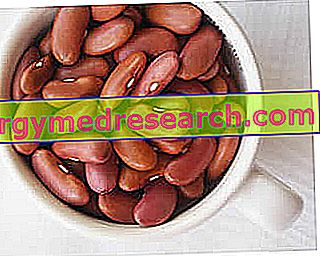Cooking legumes requires some special precautions which, if neglected, can compromise the nutritional integrity and the organoleptic and gustatory quality of the dish; it is a delicate cooking, to be carried out in abundant water, with a low flame, prolonged over time and subordinating to some equally important preparation steps.

Legumes and legumes
What and what are they?
In the kitchen, legumes are foods consisting of the seeds of some plants belonging to the Leguminose or Papilionaceae family; analogous to cereals (seeds of the Poacee or Gramineae - Gramineae ), legumes have a nutritional content that favors the intake of complex carbohydrates but, for their part, they provide more protein, minerals, fiber and vitamins.
Legumes are a wide range of plants; also broom, capraggine, liquorice, alfalfa, sweet clover, fenugreek, etc. are Papilionaceous. However, the legumes to be cooked are limited to a group of varieties of which the seeds are consumed, therefore: cannellini beans, borlotti beans, Spanish beans, black beans, Mexican beans, chickpeas, chickpeas, lentils, broad beans, peas, soy, lupins, peanuts * etc
Peanuts are not cooked like other legumes but simply roasted.
Before cooking the vegetables ...
As mentioned in the introduction, cooking legumes is a fairly delicate operation that requires some special precautions. First of all, we remind you that legumes can be marketed in different forms: fresh (only in season), frozen, in can (cooked and canned in the cooking liquid) or dried (dehydrated). Logically, those that retain the most nutritional value and organoleptic and gustatory characteristics are fresh ones, followed by frozen ones, then dry ones and finally legumes in cans. Obviously, the cooking of legumes is only necessary for the first three types, while the pre-cooked seeds do not need any heat treatment; in parallel, the precautions of which we have already anticipated the need, are to be applied EXCLUSIVELY to DRY legumes, while those fresh and frozen do not require their use. NB . Frozen vegetables, before cooking, must NOT be de-iced and brought to room temperature.
Before cooking dried pulses
Finally we come to the treatment that precedes the cooking of dried vegetables; these seeds, being dehydrated and packaged on a large scale, are not always completely free of processing waste (pod fragments, petiole, etc.), impurities (dust, stone fragments, etc.) or defects (atrophic, darkened, etc.). Therefore, the first stage of the treatment prior to cooking consists of the analysis (more or less thorough) of the seeds, and of the separation of the unwanted components; this process, which can also be carried out dry, in order to reduce the time, could be carried out simultaneously with the second pass, ie washing in running water. Washing the legumes before soaking them is useful to eliminate dust, the first impurities, the anti-fungal additives in excess, the micro-organisms already present on the food etc. We then reach the last stage of the treatment before cooking the dried vegetables; these, which are obviously dehydrated to prolong their conservation, require the reacquisition of the liquids necessary for satisfactory cooking. The water inside the seed is therefore crucial to the success of the preparation, since the starch and the soluble fibers contained within the legumes, if not rehydrated (therefore gelled) and directly subjected to the heat of the heat treatment, react by hardening further and making the food unpleasant. It follows that it is INDISPENSABLE to soak legumes for a time necessary to rehydrate them (osmosis) also according to the size and variety of the seed (some hours or a whole night); for example, the soaking time of a cannellino bean (smaller) will always be less than that of a Spanish bean (much larger). This does not remove the fact that some dried legumes with reduced dimensions and particularly permeable peel can be cooked apart from the soaking mentioned above; lentils, peas and grass peas are a common example. Moreover, although having properly selected and washed the vegetables, when possible, it would be a good habit to replace the soaking water in order to reduce the inexorable bacterial fermentation. Other precautions are: use water at room temperature and in quantities of about 3 times the weight of dried pulses (in the container the liquid must cover the seeds at least 3 cm), choose the RIGHT water for soaking (generally poor in salts and tendentially alkaline) and correct it with sodium bicarbonate (the tip of a teaspoon per kg of dried legumes) to facilitate the "breaking" of some intrinsic fibrous components and give softness to the seed during cooking.
How to do?
Let's start by pointing out that cooking legumes is essential, since the heat treatment confers digestibility to the seeds and destroys some anti-nutritional components (a small exception can be made for fresh peas, pleasant and fairly digestible - but not completely - even raw) . On the other hand, cooking legumes also means losing part of their thermolabile vitamin content.
Once selected, washed and soaked, the vegetables must cook lightly, prolonged and above all in COLD WATER (see the article: Types of Cooking in Water). The reader does not misunderstand; cooking in cold water is NOT a paradox or a futuristic culinary technique, but a simple word game that indicates a very basic type of treatment. It is done by placing the pulses inside the pot containing the still cold water, then making them gradually reach the temperature. On the contrary, cooking in HOT water (like that of pasta or refined grains, for instance) involves immersing the food in the GIA 'liquid brought to a boil. To properly cook legumes it is therefore necessary to transmit the heat in the most delicate way possible and, to do this, it is necessary to use the LIGHT BUBBLE or SOBBLIT. In short:
- Use a casserole or an ALTO earthenware pan with SPESSO bottom, suitable for prolonged cooking
- Maintain a constant temperature of around 80 ° C, identifiable by the release of a few and sporadic bubbles
- Calculate the water required for cooking on the basis of double or triple the legumes already found
- Use a lid, perhaps made of glass, to avoid having to add the evaporated liquid continuously
- Stir when needed
Lentils - How to Cook them with Few Fats
X Problems with video playback? Reload from YouTube Go to Video Page Go to Video Recipes Section Watch the video on youtubeConsiderations
First of all, remember that it may be necessary to add more bicarbonate (in addition to the one for soaking) ONLY in the presence of strongly chlorinated or acid water, taking care not to alter the taste of the preparation itself.
Secondly, I would make one final remark on the nutritional loss of dried vegetables by cooking; regardless of the fact that some of the fresh ones can also be cooked in a pressure cooker (which allows you to keep most of the water-soluble nutrients), I would point out that:
"the nutritional loss in electrolytes (calcium, iron, phosphorus, potassium, magnesium etc.) is proportional to their dispersion and dilution in water; part of these is expelled with soaking (from which it is not possible to do without), while a further portion leaks into the cooking water In the latter case, if the technique is the proper boiling (in which the extra liquid is then eliminated) the salts mentioned above are dispersed, on the contrary, if the boiling is progressively evolved into a stewing (obviously, without the initial browning), the liquid continues to evaporate BUT the electrolytes concentrate in the remaining food. This last technique is certainly advisable with respect to the proper boiling ".



